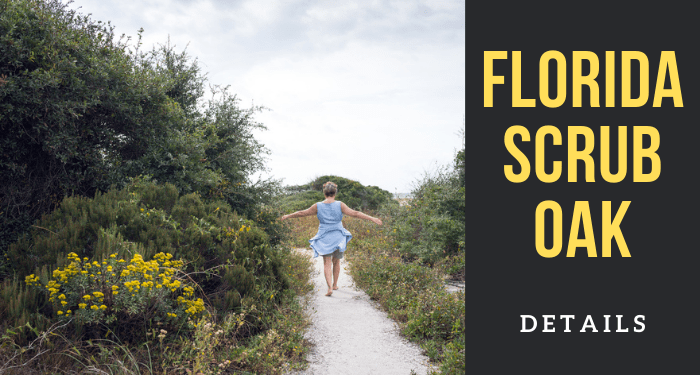Florida scrub oak tree is a small oak tree. This tree is very much native to Florida as we can assume from the name. But still there are a lot of things that we may want to know. For example we may need to know if they are poisonous and are there any species of them.
Other than these, you may be curious about other things that are relevant to Florida scrub oak trees. So, here is the article that will help you to learn all about the things related to Florida scrub oak. We hope you enjoy the article.
In this section, we would like to ponder over everything about a Florida scrub oak tree. From where they are grown, their appearances such as leaves and other things.
Scrub Oak Scientific Name
Sand Hill Oak is an evergreen small tree or large shrub in the Fagaceae (beech) family. It is native to Florida. It’s scientific name is Quercus inopina. This also has got other common names such as Florida oak, FLorida shrub oak or Sand hill oak tree.
Scrub Oak Habitat
Florida scrub Oak trees live in the Northern hemisphere. They can survive in various forests which may include those wild forests in temperate climates, Mediterranean and tropical areas.
When habitats overlap, bear oak hybridizes with several species within the red oak group. The scrub oak trees are prone to fungal diseases that may induce rotting of the inner part of the plant.
Scrub Oak Tree Leaves
As Florida scrub oak trees have different species so there are a variety of leaves according to the species. Myrtle oak has got right, shiny, rounded evergreen leaves. They are about 2 inches long and they are also glabrous which means without hairs beneath.
Chapman’s oak has left, larger, deciduous leaves with different irregular shaping and also irregular pubescence. These three oaks are found in nearly all Florida scrubs. A fourth species, inopina oak has got right, occurs in scrubs in central Florida only, and usually replaces myrtle oak.
The leaves of inopina oak are curled and directed upward. The sand live oak has left, oblong, evergreen leaves, about 2-3 inches long, also with curled-under edges and pubescence that is hairiness beneath.
Scrub Oak Acorns
The scrub oak tree is an evergreen which generally averages from 40 to 80 feet tall and 60 to one hundred feet wide. Also they are native to woods and coastal plains from Virginia down to southern Texas and Florida.
These majestic trees are a symbol of the South, with their short trunk and a low and also broad and rounded crown. They have got quite small, yellowish-greenish flowers in color and one inch long acorns that have scaly cups.
In addition to these, their acorns tend to be long and pointed. The Acorns of Florida scrub oak are an important wildlife food source
see more Husky Cherry Red Tomato
Florida Oak Trees
According to the latest reports there are about six hundred Quercus Oak tree species in this world. About 26 different oaks grow in Florida and they are either white or red oak trees. A third category which is intermediate oaks does not occur here naturally in Florida.
The difference in oak trees can be seen in the overall mature height and spread size and also in the leaves, flower style and acorns. Here, in this article we have compiled a list of different types of Oak Trees native to Florida region which are as below:
- BLACK OAK (QUERCUS VELUTINA)
- BLUEJACK OAK (QUERCUS MARILANDICA)
- BLUFF OAK (QUERCUS AUSTRINA)
- CHINKAPIN OAK (QUERCUS MUEHLENBERGII)
- LAUREL OAK (QUERCUS LAURIFOLIA)
- LIVE OAK (QUERCUS VIRGINIANA)
- POST OAK (QUERCUS STELLATA)
- MYRTLE OAK (QUERCUS MYRTIFOLIA)
- SHUMARD OAK (QUERCUS SHUMARDII)
- SOUTHERN RED OAK (QUERCUS FALCATA)
- TURKEY OAK (QUERCUS LAEVIS)
Is Scrub Oak Poisonous
Many types of wildlife animals totally depend on scrub oak acorns for food, including squirrels, chipmunks, deer, wild turkeys, and even bears. However, the plant itself is toxic. If you’ve heard of a cattle or sheep becoming sick from eating scrub oaks, it’s because of its tannic acid in the tree’s shoots.
see more Tractor Seat Plant
Is Oak Poisonous to Humans?
The tannins which are found in the leaves, bark, and acorns of most Quercus spp produce poisoning through their effect on the intestinal tract and kidney. The Tannins are normally potent precipitators of cellular protein.
Oaks at any stage of growth are poisonous but are particularly toxic when the leaf and flower buds are just blooming in the spring. As the leaves mature they become less toxic. Besides, ripe acorns are less toxic than when green.
Scrub Oak Facts
The scrub oak may not be the largest tree in the ecosystem, but it serves some important functions. The first of these is its role as a member of the under-story flora. The oak scrub is extremely resistant to drought which makes it perfect for harsh climates such as the chaparral ecosystem.
For Indigenous communities, the scrub oak is a universal natural resource that provides food, medicine and raw wood necessary for fuel and also for building homes and making weapons.
For this reason, the native American groups have been instrumental in attempts to protect the scrub oak from the risks of urbanization.
In the fall, the scrub oak’s foliage turns bright orange and can often be seen covering the side of mountains or hills. When covering a wide area like that, it is possible that all of the trees share an underground root system.
Final Thoughts
In brief, we can say that Florida scrub oak is a small shrub that is common in Florida. It has got some important role in the natural ecosystem. It has got different species which may vary in appearances and other characteristics. But we need to be careful with these shrubs as they can be toxic to both humans and pets.
